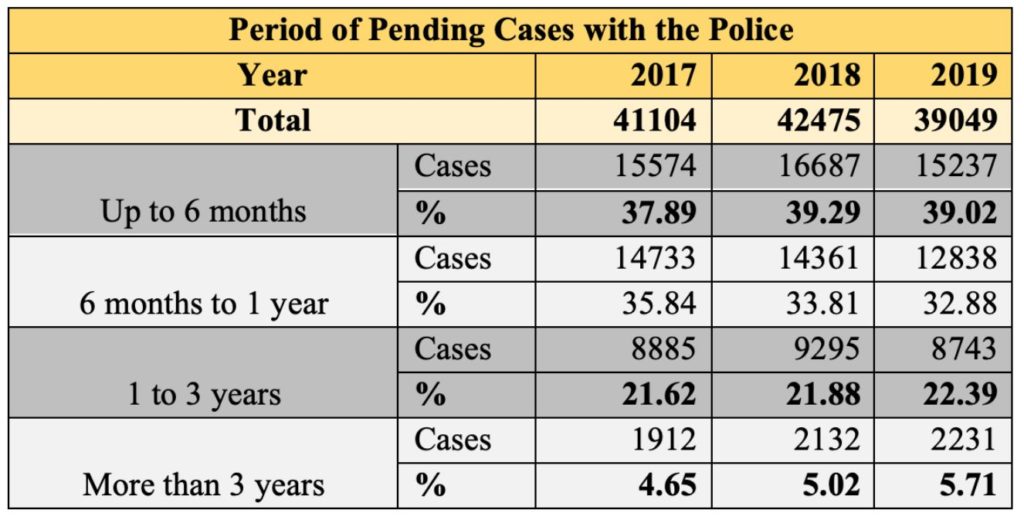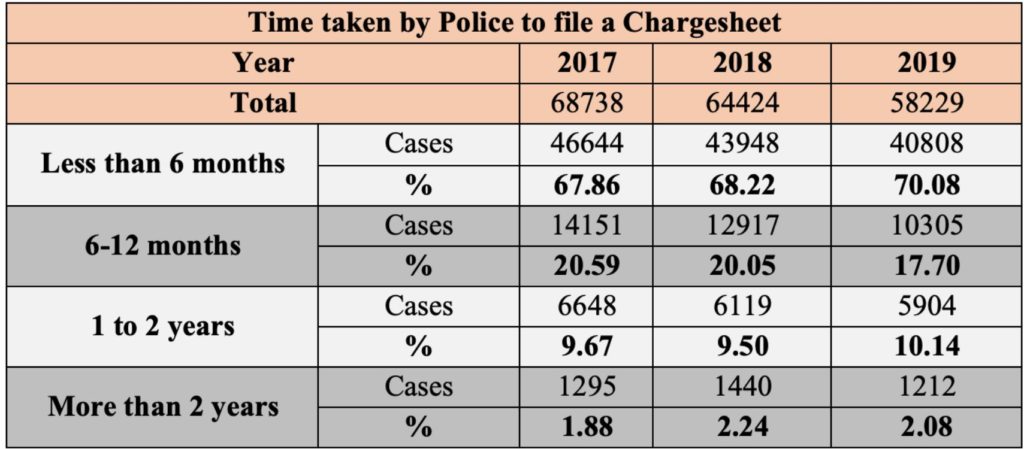The NCRB data for 2019 indicates that there is a significant decrease in the number of new ‘rioting’ cases. However, despite this fall in the number of new cases, the pendency rate of these cases has increased with the Police disposing fewer cases than in earlier years.
In an earlier story, we looked at the trends relating to registration of cases for the various offences against public tranquility. We had observed that there is a fall in the reported number of such offences, especially the number of cases registered under ‘rioting’.
The trends from the NCRB 2019 data indicate variances in reporting across the states, with the possibility of under reporting in less evident instances of offences against public tranquility such as unlawful assembly. Apart from the trends related to the registered cases, it is also important to understand the disposal and conviction rate in these cases. In this story, we take a look at the trend in disposal of these cases by the police.
Pendency rate increased in 2019 despite of the fall in the number of new cases
In the earlier story, we had observed that there was a significant drop of around 17.5% in the number of new cases reported in this category. This also meant that the number of total cases being investigated by the police for the year 2019 also reduced. The cases being investigated during any year include the number of new cases booked during the year along with the cases that were pending from the previous year.
In 2019, a total of 1.06 lakh cases were investigated by the police for offences against public tranquility. Of these cases, around 66.9 thousand cases were disposed of, and the remaining 39 thousand cases i.e. around 37% of the cases are still pending investigation by the police. This is much higher than the pendency rate of total cognizable IPC cases, which is around 29% for 2019.
By the of 2019, the absolute number of pending cases under this category was less than pending number by the end of 2018. However, this number has to be seen in the context of the significant reduction in the total number of new cases. Hence, even though the total number of pending cases reduced by the end of 2019, the pendency rate is 37% compared to the pendency rate of 35% and 36% in the two preceding years.
Meanwhile, there was also a significant drop (more than 10%) in the number of cases disposed of by the police in 2019. Police disposal includes – (i) the cases where final report is prepared by the police and, (ii) cases for which the chargesheet is filed (these cases move to the court for trial).
Disposal rate in 2017 was just above 65% which fell in the next two years to approximately 64% and 63% in 2018 & 2019 respectively.
Pendency rates for Police Disposal in ‘Rioting’ cases has increased
Cases booked under ‘Rioting’ form the major chunk of the offences against Public tranquility. Most of the trends relating to offences against Public tranquility are influenced by the trends in the cases booked for ‘Rioting’.
As in the case of overall number of offences, even in the cases relating to Rioting, although the number of total cases being investigated by the police has gone down, the pendency rate has increased. In 2019, around 79 thousand cases of rioting were being investigated by police of which 29.7 thousand cases were pending i.e 37.6% by the end of 2019. This is significantly more than the previous year (2018) when the pendency rate was only 35.5%. This increase in pendency is despite the fact that a far greater number i.e nearly 91.8 thousand cases were being investigated in 2018.
Even in 2015, where a significantly greater number of cases i.e 98 thousand cases of rioting were investigated, the pendency rate by the end of the year was lower than 2019 with 36.6%.
During this five-year period (2015 to 2019), the percentage of rioting cases disposed by police fell by over 1%. In 2015, 63.3% of cases were disposed of, which fell to 62.3% in 2019. The disposal was slightly higher in 2017 & 2018 when around 64% of the total cases were disposed of by the police.
Meanwhile, the number of cases relating to ‘Unlawful Assembly’ that are pending investigation has increased over the years. In 2017, there were around 5.7 thousand pending cases, which increased 6.2 thousand in 2019. Apart from the increase in the absolute numbers, the substantial increase in pendency rate is also a cause for concern. In 2017, 33% of the cases that are being investigated for ‘Unlawful Assembly’ were pending by the end of year. This has increased to 36% and 42% in 2018 and 2019 respectively.
28% of the cases pending with police are pending investigation for more than a year
By the end of 2019, out of the around 39 thousand cases that are pending investigation, nearly 11 thousand cases i.e around 28% are pending for over a year. Among these, around 2.2 thousand cases are pending with the police for over 3 years. These numbers have increased when compared to the previous year i.e 2018. By the end of 2018, out of more than 42 thousand cases that were pending with the police, nearly 11.4 thousand i.e around 27 % of the cases were pending for over a year.
While the number of cases pending for 1-3 years has come down in 2019, those that are pending for over 3 years has increased continuously since 2017.
The trend shows that 4 out of 10 every pending cases in this category are pending for less than 6 months. Further, more than 70% of the cases are pending for less than a year.

Around 70% of the cases are charge sheeted within 6 months
Because of the increase in pendency of cases, the proportion of cases in which a chargesheet is filed by the police has decreased over the years. In 2017, nearly 58 % of the total cased being investigated by the police were chargesheeted during the year and this reduced to 55% in 2019. It has to be noted that this has come down despite a fall in the total number of cases being investigated.
Within the cases that are being chargesheeted, it is observed that 70% of the cases are chargesheeted within a period of 6 months. This is a slight improvement over the previous years. Meanwhile, the proportion of cases where it took more than year to file the chargesheet has slightly increased.

Apart from chargesheeting, there are cases where the police file the final report (asking for the case to be closed). Out of the total cases in which a final report was filed by the police in 2018, around 13% of them were being investigated for a period between 1-2 years. This increased to 17% in 2019 (even the number of cases increased from 1393 to 1463).
The increase in proportion of cases being chargesheeted (especially within 6 months) along with an increase in disposal of long standing cases point to an urgency by the police to push through the pending cases. The quality of the investigation by the police can be ascertained to an extent by reviewing the trends in disposal of cases by the courts.
We would take a look at these numbers i.e disposal of cases by courts in the next story.
Featured Image: Pendency rate of cases


